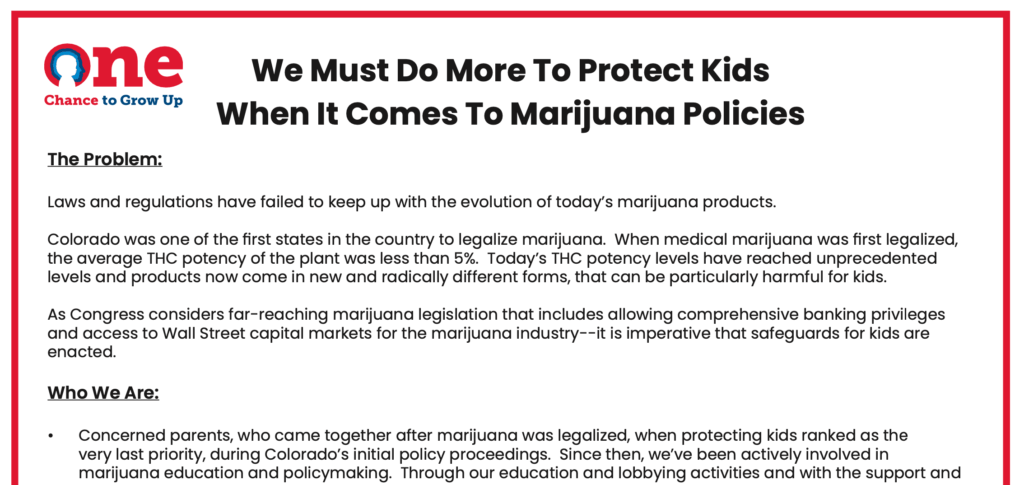The Problem: Laws and regulations have failed to keep up with the evolution of today’s marijuana products.
Colorado was one of the first states in the country to legalize marijuana. When medical marijuana was first legalized, the average THC potency of the plant was less than 5%. Today’s THC potency levels have reached unprecedented levels and products now come in new and radically different forms, that can be particularly harmful for kids.
As Congress considers far-reaching marijuana legislation that includes allowing comprehensive banking privileges and access to Wall Street capital markets for the marijuana industry–it is imperative that safeguards for kids are enacted.
Who We Are: Concerned parents, who came together after marijuana was legalized, when protecting kids ranked as the very last priority, during Colorado’s initial policy proceedings. Since then, we’ve been actively involved in marijuana education and policymaking. Through our education and lobbying activities and with the support and engagement of many thousands of citizens and key community stakeholders, we’ve helped to secure important youth safeguards and impacted over 23 pieces of legislation.
These safeguards include product testing and labeling including THC and CBD potency, warnings, packaging, data collection, edible markings and serving size limits, pregnancy warnings, education funding, potency study, delivery and on-site club restrictions, reducing home grows, advertising limits, and important local restrictions.
In 2020, we launched our One Chance to Grow Up Initiative, to share what we’ve learned with US Congress members, national leaders, and other states.
What We’ve Learned: There’s a big difference between low THC and hemp-derived products versus today’s ultra-high THC products and strains. Yet, confusion and misleading information about these different products and THC potencies continue to persist, creating tremendous risks and harms for the public, and particularly for kids.
There is a big difference between decriminalization and legalization versus full-blown unlimited commercial production and sales.
The past war on drugs unfairly targeted communities of color and the nation’s drug policies should address that. However, marijuana commercialization disproportionately hurts neighborhoods of color and the young people growing up there, creating a new inequity.
The words “marijuana” or “cannabis” don’t adequately describe today’s new high THC products, which include kid-friendly, concentrated and easily concealable forms like dissolvable powders, vapes, inhalers, and suppositories reaching THC potencies of 98%.
Why This Problem Must Be Addressed: Rising THC potencies are a growing threat to growing brains, which are developing into the mid-20s. The following consequences are occurring in Colorado.
Emergency departments are seeing more people in crisis from these extremely high THC products
THC is now the number one substance found in youth teen suicides
Studies show high amounts of THC have been linked to anxiety, depression, addiction, suicidal ideation, psychosis, and schizophrenia
The number of vehicle fatalities where marijuana was found in the driver’s system increased 153% between 2013 and 2017
High-school aged youth are twice as likely to drive after using marijuana than after using alcohol
High-school students report their usual method of use as dabbing concentrated THC at rates nearly 3 times higher than adults
A major study found that nearly 70% of the 400 marijuana dispensaries contacted were recommending marijuana for pregnant women
Recommended Policy and Regulatory Measures: Meta-analysis of current research, to determine at what THC potency levels and concentrated amounts negative health effects arise – so, policymaking can be guided by the science, while allowing for more research on today’s high THC products
Immediately dedicate funds for robust education and prevention for youth and pregnant and lactating women
Collect key data to assess impacts, costs, and benefits, and to determine best practices and regulatory measures
Address THC potency gaps in Farm Bill to include Delta 8 and 10
Treat “medical marijuana” more like medicine by requiring prescribing recommendations, that specify THC potency and amounts, product type, intake method, and timeframe, and address false claims
Prohibit kid-friendly products including flavors and strictly limit advertising and marketing
Cap THC potency and require standard serving sizes and limits per package
Require childproof packaging, and full disclosures including potential risks on labels and at point of sale
Christopher Hatcher, Williams & Jensen, cwhatcher@wms-jen.com
Marti Thomas, Williams & Jensen, mthomas@wms-jen.com
Doug Robinson, Chairman of the Board, One Chance To Grow Up, doug@onechancetogrowup.org
Diane Carlson, Policy Director, One Chance To Grow Up, diane@onechancetogrowup.org
Henny Lasley, Executive Director, One Chance to Grow Up, henny@onechancetogrowup.org


